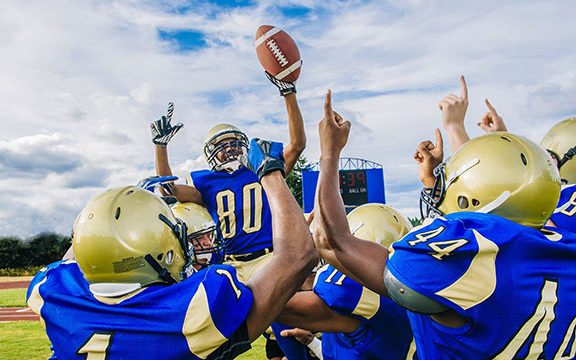
By Chris Rotolo
MIDDLETOWN – What do athletes and inmates have in common?
It’s a question Mitch Abrams, Psy.D., has considered regularly as the chief psychologist of Rutgers University’s Correctional Healthcare unit – which oversees mental health services for seven state prisons in New Jersey – who has more than 25-years of experience as a certified sport psychologist.
“How are these groups similar?” Abrams asked during a Jan. 30 presentation at Middletown High School North for families of adolescent athletes. “First of all, they’re human. Developmentally they tend to be poor at appreciating the big picture and future plans. They don’t always consider the consequences of their actions. And they’re often misunderstood.”
Abrams, an expert in the domains of anger management and violence prevention, appeared in Middletown to help parents and guardians of developing athletes better understand the signs that high-functioning individuals may be struggling to maintain an atypical lifestyle under the stresses and anxieties that accompany participation in athletics.
“One thing I am worried about, is that over time there have been real mixed messages that kids get in the sports world about emotions,” Abrams said. “What’s happened for a lot of athletes is they’ve been told ‘Do not talk about how you feel.’ There’s no crying in baseball, right? It’s horrible advice.”
Abrams guided the audience through a number of crucial topics to help audience members support their athletes through the many unique pressures they experience; none more important than the power of positive affirmations.
Letting Them Know
The car ride home after a game is an impactful environment for athletes, parents, guardians and coaches. As Abrams indicated, that impact is not always positive. The healthiest course of action for post-game activities is often a simple affirmation of love and support, rather than offering critical feedback.
“There’s really nothing more powerful you can say than, ‘I love watching you play. Did you have fun?’ It’s not about critiquing their play, so they wind up hating the ride home. Never let your child have an opportunity to wonder how you feel about them. Ever. There will be times they stiff arm and run away because they think it’s embarrassing. But they need to know,” Abrams said.
The Importance of Language
Abrams discussed the use of emotional language among athletes and the difficulties adolescent athletes experience with expression.
“The biggest problem with athletes in this regard is that they’re already acculturated to not talk. I would rather an athlete tell me that they feel like they want to kill themselves than them not saying anything at all,” Abrams said.
Abrams stressed the importance of parents, guardians and coaches establishing language structure for their athletes that creates an environment founded on respectful, open communication.

“If you squash language too much, you can’t complain when people don’t talk to you about what their issues may be. I don’t believe there is a more difficult thing in the human condition than loneliness. And as an athlete, when you’re on a team surrounded by your peers and coaches, and you feel completely alone, and like you can’t talk to anyone about it, what do you think that’s like? There’s almost nothing that can be said that can’t be fixed afterward,” Abrams said.
When an athlete talks about how they feel, they can then identify why they feel that way, which can lead to the regulation and mastery of their emotions, and can support their athletic endeavors.
Whose Dream Is It?
During the presentation, Abrams displayed a report by the National Collegiate Athletics Association (NCAA) showing the sport-by-sport percentage of high school athletes who will compete at the NCAA level in some capacity (Division I, II or III).
For men, lacrosse (12.8%) and ice hockey (12.3%) were the only NCAA sanctioned sports to see more than 7.5% of athletes make the jump. For women, ice hockey (26.2%), lacrosse (12.5%) and field hockey (10.1%) were the only sports to see more than 7.5 percent of athletes make the transition. These figures comprise athletes who do and do not receive athletic scholarships to compete. The percentage of scholarship athletes is significantly lower.
“I hear parents, from the time their kids are 3 or 4 years old, say how they’re going to play lacrosse at Johns Hopkins. The statistics show, probably not. If so, great! The NCAA doesn’t share this information to rain on a kid’s dream, but the question then becomes, when is it about the kid’s dream? Or is it the parent’s dream?” Abrams asked.
Abrams asked audience members to consider the motivating factors behind their athlete’s participation in sports and asked them to be mindful of their influence on the adolescent.
“It takes so much work just to compete in high school, let alone college, or professionally. And because of that they have to be doing it for themselves, not for you.”
Burnout Versus Depression
At some point during their season, an athlete may experience burnout, a syndrome that can result from the chronic stress of continued demands in a sport or activity without the opportunity for physical and mental rest and recovery. Burnout can be remedied by healthy sleeping habits and even taking extended time away from competing in a particular sport to focus on another activity.
Abrams stressed the importance of differentiating activities and promoted the notion of developing adolescents to be multisport athletes.
“All of the research shows that athletes who play multiple sports are better off across the board. They don’t suffer overtraining injuries as often. They do better socially. And their bodies tend to be more robust because they’re training antagonistic muscles instead of the same group over and over again.”
Burnout from an activity can dissipate with time, which is how it differs from clinical depression. The latter is a mental health disorder characterized by a despondent mood, loss of interest in activities, and significant impairment in daily routines. Encouraging communication about their feelings can help parents, guardians and coaches distinguish between burnout and depression, and provide support for their athletes accordingly.
The article originally appeared in the February 2 – 8, 2023 print edition of The Two River Times.














